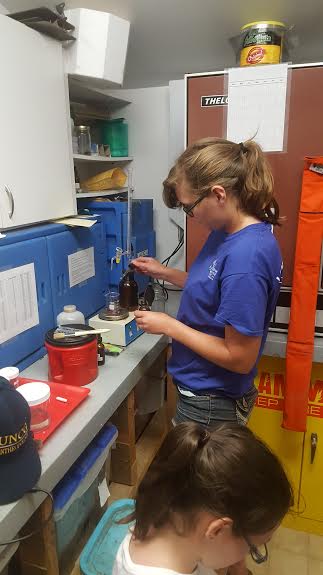Summer is winding down and the 2016 Lighthouse Archaeological Maritime Program (LAMP) field school has successfully concluded. This year we had 12 students from across the country come to the Lighthouse. They came to learn about underwater archaeology, enhance their diving skills and help excavate our new Anniversary Wreck site. They also were able to learn about the important work that goes on post-field school, such as public outreach and conservation.
With such a large class of students, it was difficult to have them all out on the water and diving every day. To help ease congestion on the boats, the students were divided into three groups. Each group would then rotate through different responsibilities involved with the boat, diving or back on land at the Lighthouse.
While the field school students were here at the Lighthouse, they shadowed the supervisors and volunteers to learn the behind-the-scenes tour. This way the students were also able to learn about the history of the Lighthouse grounds and the boatworks while engaging the public.
In years past, in order to do public outreach and tell visitors about LAMP, we had the students man a tent outside in the courtyard. We would have a few artifacts, some photos and the site plan to show guests what the Storm site looked like. Now, though, we have the fantastic Wrecked! exhibit to show off to the public.
One added benefit to having the new exhibit in the museum (besides letting everyone enjoy air-conditioning instead of a tent outside) is the extra time for the students. We were able to use these days to teach the field school some basics of archaeological conservation conducted here at the Lighthouse.
Ordinarily we would start by X-raying an artifact and then removing the concretion with an airscribe. Unfortunately, we were not able to go that in-depth with the students. Instead, we started with a few objects that had already been de-concreted and were ready for the next phase.
First, they took pictures and started artifact cards for each of their projects.
Next, they learned how to rig up the electrolytic reduction container. They connected the appropriate wires to the corresponding positive and negative anodes of the direct current power supply. Then they attached the negative wires to the artifact, and the positive wires to the metal anodes in the tank. The students then mixed the electrolyte solution for the artifacts. Once everything was in place, they turned the power on and made sure it all worked according to the plan.
In order to teach the students how electrolytic reduction works, they also learned how to monitor the process. They took titration readings that show the levels of chlorides in a given solution. By measuring the trace amounts of chlorides and tracking it over time, one can see the amount coming out of the artifact. This will then show how much longer the artifact needs to be in electrolytic reduction.
The 2016 season was another successful field school year, full of some great work and discoveries on site offshore. However, it was even more exciting and rewarding to be able to give the students some first-hand conservation experience.
Andrew Thomson is the Assistant Conservator for the St. Augustine Lighthouse & Maritime Museum. He received his graduate degree and training from the Conservation Research Laboratory at Texas A&M.





